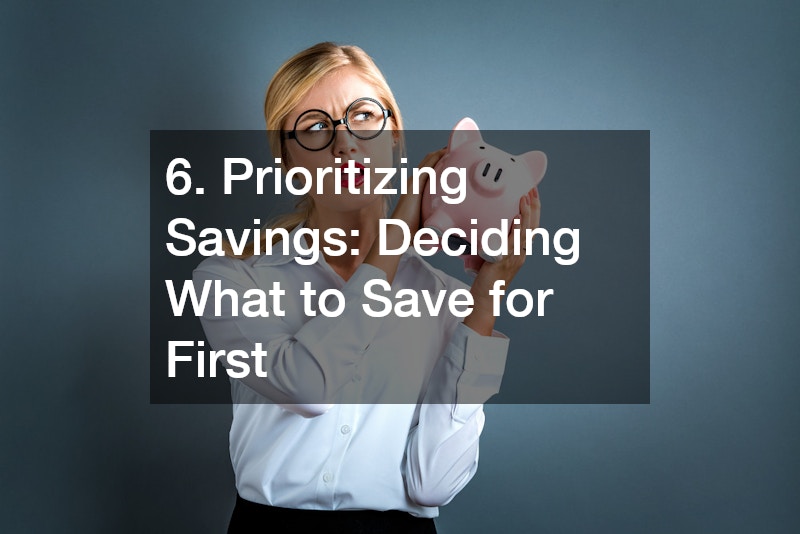
When it comes to major life milestones like buying a home, maintaining your health, or owning a car, smart budgeting is essential. To save smarter, you need to approach each goal with a clear plan and prioritize your spending wisely. Life’s big expenses often come with a lot of stress and uncertainty, but planning ahead can help you save for these significant purchases and manage the costs effectively. In this article, we’ll cover seven budgeting tips for achieving these milestones without compromising your financial future.
The Importance of Budgeting for Life’s Big Expenses
Before diving into the specifics of saving for a home, health, or car, it’s crucial to understand the role budgeting plays in reaching these life milestones. Budgeting provides a clear roadmap for managing income and expenses, ensuring that you’re not living paycheck to paycheck. It allows you to allocate funds toward savings goals, plan for future needs, and avoid unnecessary debt.
By creating and adhering to a budget, you can prioritize your savings and adjust your spending to meet your goals. Whether you are planning to buy a home, prepare for medical costs, or purchase a car, having a solid financial plan in place will give you the confidence to make decisions that align with your long-term objectives.
1. Create a Comprehensive Budget by Building a Foundation

The first step in saving for any major expense is creating a comprehensive budget. A well-crafted budget acts as the foundation for all of your financial decisions. Here’s how to start:
Track Your Income and Expenses:
Begin by calculating your monthly income after taxes. Then, track your fixed expenses (rent, utilities, subscriptions) and variable expenses (groceries, entertainment, shopping). Understanding where your money is going is crucial to making adjustments that can help you save.
Set Clear Savings Goals:
For each major life milestone, set specific financial goals. For example, if you’re saving for a home, determine how much you need for a down payment. If it’s medical expenses, estimate how much to set aside for insurance premiums and out-of-pocket costs. Be realistic about the timeline and the amount you can save each month. Similarly, consider long-term financial planning tools like indexed universal life insurance to help build cash value over time.
Once you’ve got an overview of your finances, categorize your spending into necessary, discretionary, and savings categories. This will help you identify areas where you can cut back and reallocate funds to your savings.
Automate Your Savings:
Automating savings is one of the easiest ways to stay consistent. Set up automatic transfers to a savings account specifically for your goals, whether it’s a high-interest account for emergency funds or a dedicated down payment fund for a home.
Review and Adjust:
Periodically review your budget to ensure that you’re staying on track with your savings goals. Life changes, so it’s important to adjust your budget as needed to reflect changes in income, expenses, or financial priorities. Additionally, if you own a car, be sure to factor in any necessary repairs or maintenance costs, especially when choosing auto repair companies that offer reliable services within your budget.
2. Save for Your Dream Home

Buying a home is one of the most significant financial milestones for many people, but it requires long-term planning and discipline. The key to homeownership is saving for the down payment and associated costs. Here are some tips to get you started:
Determine Your Budget:
Understanding how much you can afford is the first step in saving for your dream home. Factor in your current income, existing debts, and monthly expenses to determine a comfortable price range for your home. Use online mortgage calculators to get an estimate of what you can afford based on interest rates and down payment percentages.
Start Saving for a Down Payment:
Typically, homebuyers are advised to save 20% of the home’s purchase price for a down payment. While this might seem like a large sum, it can be achievable with consistent savings. Consider setting up a separate savings account to keep this money untouched and allow it to grow.
Additionally, the purchase of a home comes with other associated costs, such as:
Closing Costs:
These can range from 2% to 5% of the home’s purchase price and include fees for inspections, appraisals, and attorney services.
Homeownership Costs:
Be prepared for ongoing expenses like property taxes, homeowners insurance, maintenance, and repairs. If the home has a pool, you may also need to budget for swimming pool maintenance. These costs can add up, so it’s important to include them in your long-term planning.
Monthly utility bills, including electricity, water, and gas, can also be significant. Consider investing in energy-efficient appliances or home improvements, such as better insulation or solar panels, to lower these recurring costs.
Title Company Fees:
When purchasing a home, you’ll also need to account for the fees associated with a title company. They play a crucial role in ensuring the property has clear ownership and facilitating the closing process, including conducting title searches and providing title insurance to protect your investment.
3. Budget for Medical Expenses and Insurance
Health is wealth, and when it comes to budgeting for major life milestones, ensuring you have the proper medical coverage is just as important as saving for a home or car. Medical expenses can be unpredictable, but with proper planning, you can avoid financial strain.
Invest in Health Insurance:
One of the best ways to save on medical costs is by securing comprehensive health insurance. Compare plans and premiums to find the best coverage for your needs. Consider factors like deductibles, co-pays, and out-of-pocket maximums to understand what you’ll pay in the event of an emergency or routine visit.
Build a Health Savings Account (HSA):
An HSA is a tax-advantaged account that can be used to save for qualified medical expenses. If you have a high-deductible health plan (HDHP), you can contribute to an HSA and use it for medical bills, prescriptions, or even long-term care needs.
Additional Health-Related Expenses to Consider:
Other health-related expenses to consider in your budget include:
Routine Medical Expenses:
These could include dentist visits, vision care, and physical therapy.
Emergency Funds for Health:
Unexpected medical events can create a financial burden, so it’s crucial to have funds set aside specifically for health emergencies, including surgeries or extended hospital stays.
Diagnostic and Treatment Costs:
Consider the potential costs of diagnostic tests like an open MRI test, which may be required for specific conditions. It’s important to account for this when budgeting for health expenses.
Additionally, treatments may be necessary for certain conditions, and these can be an ongoing cost to consider when planning for medical expenses.
Preventive Care:
Investing in preventive care can reduce the likelihood of costly medical emergencies down the line. Regular check-ups, screenings, and treatments like IV therapy, when recommended by a healthcare provider, can help maintain overall wellness and prevent more serious health issues. Many insurance plans cover preventive services at little to no cost, making it an effective way to safeguard both your health and your wallet.
4. Plan for Car Ownership

Cars are essential for many people’s daily lives, but owning one comes with a range of expenses beyond just the purchase price. Here’s how to budget for car ownership:
Car Purchase:
If you’re saving to buy a new or used car, start by researching prices and determining how much you can afford. Consider whether you’ll buy outright or take out a loan. If financing the vehicle, calculate monthly payments, interest rates, and the term of the loan.
To take advantage of discounts and incentives, consider shopping during end-of-year sales or promotional periods. Don’t forget to check the vehicle’s history and reliability ratings, especially when purchasing a used car, to ensure it’s a worthwhile investment.
Car Maintenance and Repairs:
A reliable vehicle requires ongoing maintenance. This can include oil change service and unexpected repairs. Additionally, budgeting for new tires is important, as tire replacements are necessary over time. Setting aside money each month for car upkeep will help prevent surprise expenses that could derail your budget.
Insurance:
Car insurance premiums can vary based on the car model, your driving record, and coverage type. Shop around for the best rates, and ensure you have comprehensive coverage that protects you in case of an accident.
Fuel Costs:
Depending on your driving habits, fuel can become a significant expense. Look for ways to save on fuel, such as carpooling or choosing a fuel-efficient vehicle.
Registration and Taxes:
Don’t forget about annual registration fees and taxes associated with owning a car. These costs should be factored into your car ownership budget.
5. Build Emergency Funds
While saving for major life milestones is essential, having an emergency fund is just as important. Life is full of unexpected challenges—car accidents, home repairs, medical emergencies—that can derail your financial plans if you don’t have a cushion to fall back on.
Start Small and Build Gradually:
If you don’t already have an emergency fund, start by saving at least $1,000. Over time, aim to build up three to six months’ worth of living expenses. This will provide a financial safety net in case of job loss, illness, or unexpected expenses related to your home, health, or car.
Use a Separate Account:
Keep your emergency savings in a separate account from your everyday spending money. This way, you won’t be tempted to dip into the fund for non-emergencies.
An emergency fund can be used for any number of unexpected situations:
Home Repairs:
A broken furnace, leaking roof, or appliance failure can be costly, and an emergency fund can help cover these expenses without disrupting your long-term savings.
Car Breakdown:
Whether it’s a flat tire or a major engine issue, having funds set aside for car repairs will keep you from falling into debt. If your car breaks down unexpectedly, emergency towing services may also be needed to get it to a repair shop. Additionally, if the issue involves more complex repairs like transmission repairs, it’s essential to have the emergency fund ready to cover the costs.
6. Prioritizing Savings: Deciding What to Save for First

When it comes to saving for multiple big expenses, it’s important to prioritize your goals. You might not be able to save for everything at once, so it’s essential to decide which goal takes precedence. By focusing on your most immediate needs, you can save smarter and make steady progress toward achieving your financial objectives.
Emergency Fund First:
It’s generally recommended to build your emergency fund first. Without this cushion, you might have to rely on credit cards or loans in times of financial need, which could hurt your long-term goals.
Home Purchase or Health Savings Next:
Once your emergency fund is established, consider which goal is more urgent. If you’re renting and need a home soon, you may want to prioritize saving for a down payment. Alternatively, if you have looming medical bills or need to upgrade your health insurance, that may take precedence.
7. Cut Costs Without Sacrificing Quality
Finally, it’s important to find ways to cut costs without sacrificing quality, especially when budgeting for major life milestones. Here are a few strategies to help you save without feeling deprived:
Comparison Shop:
Whether you’re buying a car, shopping for home supplies, or selecting a health insurance plan, compare prices before committing. Look for discounts, coupons, or sales that can reduce your expenses.
Buy Used or Refurbished:
Consider purchasing used or refurbished items when possible. This can apply to everything from furniture for your home to cars and electronics. Just ensure that the item is in good condition.
Negotiate:
Don’t be afraid to negotiate prices, whether it’s with service providers (like cable or internet) or when buying a car. Often, companies are willing to offer discounts to retain customers.
The Bottom Line
Saving for your home, health, and car is no small feat, but with careful planning and disciplined budgeting, these milestones can become achievable. By building a comprehensive budget, prioritizing savings, and cutting costs where possible, you’ll be better equipped to tackle these major expenses with confidence. Start by creating a solid financial foundation today, and watch your dreams become a reality.